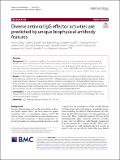Diverse antiviral IgG effector activities are predicted by unique biophysical antibody features
Author(s)
Cheng, Hao D.; Dowell, Karen G.; Bailey-Kellogg, Chris; Goods, Brittany A.; Love, J. C.; Ferrari, Guido; Alter, Galit; Gach, Johannes; Forthal, Donald N.; Lewis, George K.; Greene, Kelli; Gao, Hongmei; Montefiori, David C.; Ackerman, Margaret E.; ... Show more Show less
Download12977_2021_Article_579.pdf (2.600Mb)
Publisher with Creative Commons License
Publisher with Creative Commons License
Creative Commons Attribution
Terms of use
Metadata
Show full item recordAbstract
Abstract
Background
The critical role of antibody Fc-mediated effector functions in immune defense has been widely reported in various viral infections. These effector functions confer cellular responses through engagement with innate immune cells. The precise mechanism(s) by which immunoglobulin G (IgG) Fc domain and cognate receptors may afford protection are poorly understood, however, in the context of HIV/SHIV infections. Many different in vitro assays have been developed and utilized to measure effector functions, but the extent to which these assays capture distinct antibody activities has not been fully elucidated.
Results
In this study, six Fc-mediated effector function assays and two biophysical antibody profiling assays were performed on a common set of samples from HIV-1 infected and vaccinated subjects. Biophysical antibody profiles supported robust prediction of diverse IgG effector functions across distinct Fc-mediated effector function assays. While a number of assays showed correlated activities, supervised machine learning models indicated unique antibody features as primary contributing factors to the associated effector functions. Additional experiments established the mechanistic relevance of relationships discovered using this unbiased approach.
Conclusions
In sum, this study provides better resolution on the diversity and complexity of effector function assays, offering a clearer perspective into this family of antibody mechanisms of action to inform future HIV-1 treatment and vaccination strategies.
Date issued
2021-10-30Department
Massachusetts Institute of Technology. Department of Chemistry; Massachusetts Institute of Technology. Department of Biological Engineering; Koch Institute for Integrative Cancer Research at MIT; Ragon Institute of MGH, MIT and HarvardPublisher
BioMed Central
Citation
Retrovirology. 2021 Oct 30;18(1):35
Version: Final published version